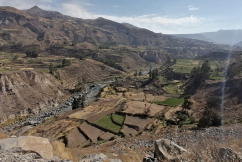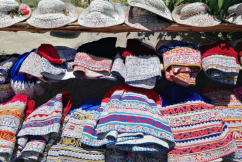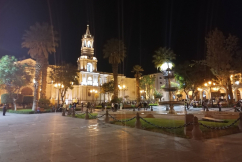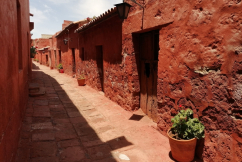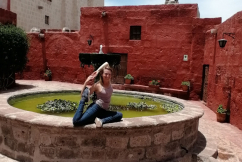Arequipa is Peru’s second largest city known as “The White City” as many buildings around the Plaza de Armas were constructed using volcanic sillar from the surrounding volcanoes. Earthquakes are as common as varied festivals in this region where travellers come to admire the second deepest canyon in the world – Colca with its volcanos and thermal springs, great cuisine and abundant traditions which include wearing beautiful costumes in the provincial, rural areas.

Canyon Colca
With a depth of more than 4 000 metres, pre-Inca roots and a colourful culture still visible today, Colca Canyon attracts over 120, 000 visitors each year. The canyon was declared a part of the World Network of Geoparks by UNESCO in 2019.
During the pre-Inca era, the valley of the canyon was inhabited by two groups of people: the Quechua-speaking Cabanas and the Aymara-speaking Collaguas, who moved to the canyon from Lake Titicaca. It is believed that the Incas arrived to the site around 1320 AD. It is also believed that they did not establish themselves in the canyon through the use of warfare, but rather through marriage and inter-connection with the Cabanas and Collaguas. Following the settlement of the Incas, the Spanish arrived under the command of Gonzalo Pizarro in 1540. In the 1570s, the Spaniards forced the inhabitants of the canyon out of their homes and to centrally located pueblos, which to this day remain the main towns of the area; amongst them there is Yanque and Chivay. There are varied options of accommodation in the heart of the valley, from luxurious hotels to rustic lodges.
A number of different tours with local guides are offered throughout Colca Canyon, varying in length and price range. The official Arequipa Colca Canyon entrance fee is 70 soles.The canyon is truly photogenic, with its terraced fields and the perfect feng shui of rivers and hills.
When in the zone, make sure to give a try to the fresh sancayo cactus juice. You might even get it as a cocktail with pisco.
The distance from Arequipa to Colca Canyon is between 3-4 hours by bus.
These are some of the popular things you can do and see in the canyon:
1. The breath-taking condor viewpoint at Condor’s Cross
2. The local villages such as Maca where you can admire local folklore and try out some dances in the traditional costumes (which are hand- embroidered; the complete female costume, including the lovely hat, costs about 500 USD)
3. The thermal springs in Chacapi, where you can enjoy some wonderful views and even swim in the Colca river (if you don´t mind colder waters and abundant river plants)

4. The National reserve where there are salt reservoirs

5. Visit varied archaeological sites
6. Llama and alpaca farms as well as bee farms
7. Hike a volcano – the service of a professional mountain guide is highly recommended; the best time of year to hike an Arequipa volcano is between July and November, when the temperatures are higher
The Most Famous Volcanos of Arequipa
1. Misti (Dormant)

Located 20 km northwest of Arequipa at the altitude of 5 822 metres above sea level, El Misti volcano is undoubtedly the most prominent feature of the landscape surrounding Arequipa. You should be physically prepared for the two-day excursion to the volcano, since during the first day the walk is about 6 hours and on the second day it is more than 7 hours at a high altitude and with very little oxygen. You spend the night at 4,610 meters above sea level.

2. Coropuna (Dormant)
This is Peru’s highest volcano at 6,425 metres. It has been active for almost 5 million years. The Coropuna holds the world’s oldest irrigation system, put in place hundreds of years ago by the Incas. This Volcano is also hope to the world’s second largest tropical ice cap. However, as a result of global warming it is estimated that the ice cap will have melted by 2045.
3. Ampato (Extinct)
After Coropuna, this is Peru’s second largest volcano, peaking at 6,288 metres. Ampato is a part of the north-south chain of three volcanoes; Hualca Hualca and Sabancaya. This was the resting place of ‘Juanita the Ice Maiden.’ This young girl, believed to have been between 12-15 years of age was supposedly killed as a sacrifice to the Gods during the reign of the Inca Empire. Since the discovery of the perfectly preserved frozen mummy in 1995, the body has been preserved in Museo Santuarios Andinos, a museum dedicated to her sacrifice.
Arequipa – The White City

The best way to explore the city of Arequipa is simply on foot. It is certainly recommended to also take a night walk. You can also make use of free walking tours available in both Spanish and English. On the tours, you will visit the most architecturally impressive and important buildings of the city (amongst them e.g. the first hotel and the first jail ever built in Arequipa or the alpaca zoo). Check out HERE and HERE for more details.
Recommended Sightseeing Spots
1. Plaza de Armas with the city hall – best at night
2. San Camilo (food and herb) Market
3. Santa Catalina Monastery – a widely renowned colonial architectural masterpiece, which once was home to a large group of nuns and now houses only approximately 20 nuns living in the northern corner
4. Yanahuara Viewpoint – Arequipa is known for its surroundings volcanos (The Misti, Chachani and Pichu Pichu) out of which the most prominent one is Misti; to get the best view of these three volcanos, walk 2 km from the historical centre of Arequipa to this viewpoint which was built using white ashlar in which the words of local poets are engraved. At the square by the viewpoint you can buy the traditional cheese ice cream (one of the renowned companies that produces it is called Charito).
5. The Andean Sanctuary Museum – this is where you find the frozen, preserved body of a young Inca girl sacrificed to the gods on the extinct Ampato Volcano
6. Bolognesi Bridge – the oldest bridge in the city offers a fantastic view of the surrounding volcanoes as well as the river rushing by below.
Santa Catalina Monastery: The Architectural Masterpiece

The Santa Catalina Monastery is renowned worldwide as a colonial architectural masterpiece. The monastery is home to many complex rooms, beautiful plazas, ornate fountains and winding cobblestone streets.
This monastery was founded in 1579 by a rich widow, Maria de Guzman. At the time, it was a tradition that the second son or daughter of the family would enter into a life of service. Only women from upper-class families were accepted. They had to pay a dowry in order to enter the service, therefore not many poorer women could enter. If a woman was to enter the monastery as a choir-nun, she would have to pay a dowry of 2,400 silver coins (the equivalent of approximately $150,000 today. Nuns served as novices for 4 years. At the end of that period, the novice could choose between entering into a full life of service, or leaving the convent, which meant bringing shame upon her family.
In 1871, Pope Pius IX sent a strict Dominican nun, Josefa Cadena, to reform the Santa Catalina Monastery. She sent all the rich dowries back to Europe, freed all the serving slaves and allowed them to choose whether to remain in service in the monastery or leave. In the 1960s, the monastery was struck by two powerful earthquakes, severely damaging the inner structures and forcing the nuns to build newer accommodation next to the monastery. The damaged areas of The Santa Catalina Monastery were gradually restored and are now open to the public.
Imata Stone Forest
Peru is known for its Smurf houses, also called Stone Forests, for example that of Abancay in Pampachiri. Much closer to Arequipa, about a two hour and a half drive, one encounters one such place called Imata. There are various tour going from Arequipa to Imata, passing through the National Reserve Salinas y Aguada Blanca and some combining the tour with Pillones Waterfall. The stunning stone formations are located in a high Andean area near imposing volcanoes, the eruption of which caused their appearance thousands of years ago. The further process of erosion subsequently caused the formation of different surreal figures. Imata is also the natural habitat of some medicinal plants of the Andes, such as ichu, yareta, and chachacoma, which is used to remove the altitude sickness by simply rubbing it and inhaling the scent.

Important to Know When Visiting Arequipa
Weather
February is the month where Arequipa experiences most rainfall. Otherwise, Arequipa is prone to quite mild weather, therefore weather is not as much of an issue when planning your visit.
Best Souvenirs
Just like Cuzco, e.g., in Arequipa you encounter many shops and street vendors with the artisanal clothing made of alpaca wool. Some amazing souvenirs may be bought in Canyon Colca, especially by the Condor´s Cross, where local women are selling traditionally-embroidered clothes and accessories. For those with a sweet tooth, get several packages of the La Ibérica toffees.
Not to Miss Out On
Arequipa white water rafting is a great way to experience the natural landscape of the Arequipa Region. Most expeditions take place on the Río Chili, 20 minutes outside of the city. These tours offered are of varied difficulty, from degree I to degree IV rapids.
There are a number of different operators that offer different white water rafting packages, allowing the customers to choose whichever length of time suits their travel itinerary.
Arequipa´s Peculiarity
This region has a position in Peru similar to that of Catalonia in Spain or Brittany in France – the residents would allegedly like to become independent…
HERE is a video from Canyon Colca and Arequipa, starting at 2:40.

